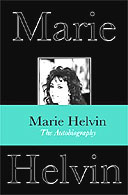
The Autobiography
by Marie Helvin
Weidenfeld & Nicolson £20, pp279
What a rarefied world Marie Helvin has lived in. Her autobiography, a star-studded and lucid account of a childhood spent in Hawaii that progresses to a modelling career working almost exclusively with David Bailey, will certainly raise eyebrows. From abortion, the death of her sister and a slew of failed relationships, it's all here, aided by ample photographic padding: of the 48 photographs, only 12 see her more than semi-clothed, but let's face it, this is why Marie Helvin became who she is now.
To begin, it's all papayas, acid and a vague nod to the Korean War; idyllic but sour times that led to the family moving from Hawaii to London and Helvin being scouted in Japan. Predominant throughout, however, is the image of a precocious young woman with a wonky jaw. Her sexual awakening, even before she was using KY jelly to slick back her hair as a teen, was on the knee of Marlon Brando at the tender age of 10. And while her overt sexual awareness may have secured a modelling career, it also contributed to the demise of her marriage to Bailey.
She became remarkable for her ability to tan quickly and eat cream cakes without putting on weight and drifted steadily into the world of couture fashion, loitering backstage with Jerry Hall, her 'terrible twin' (she's godmother to Elizabeth Jagger). And thus she met Bailey - she refers to him throughout by his surname. Unsurprisingly, his predatory Svengali presence looms over more than half the book.
He was unfaithful and arrogant and had the nerve to document their marriage in his explicit 1980 photographic journal, Trouble and Strife, which often saw Helvin in compromising shots or covered entirely in newspaper save a breathing hole.
Helvin remains notably upbeat throughout. She credits Bailey for developing 'her look', ultimately an exploitative take on her mixed roots, and accepted his foibles, his addictions and his womanising - 'love and monogamy inseparable' - as life-affirming. Deluded she may be, but she still manages to create a tenderly rendered and hearty account, albeit one packed with nauseating name-dropping, tabloid dalliances and oddly placed Jung quotes.

